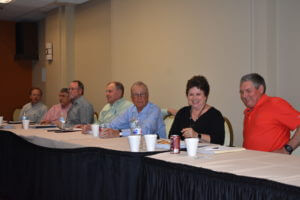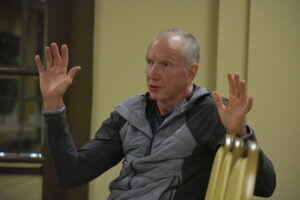
Board members from the River Place Limited District and the River Place Homeowners Association met for a joint meeting April 4 to discuss the upcoming election that will include ratifying the Limited District as well as its property tax rate. (from left) Tim Mattox, Ivar Rachkind, Scott Crosby, Pat Reilly, Lee Wretlind, Claudia Tobias and Art Jistal. Leslee Bassman
Voters set to approve district, tax rate May 5
By LESLEE BASSMAN, Four Points News
Although the Strategic Partnership Agreement, or SPA, between the city of Austin and the River Place Municipal Utility District provided for a maximum $0.50 per $100 valuation ad valorem tax, the subdivision’s River Place Limited District officers voted unanimously April 4 to instead cap that property tax at $0.15 per $100 of assessed valuation. The MUD was converted into a Limited District when the community was fully annexed by Austin on Dec. 15.
The meeting, held between the River Place Homeowners Association and the Limited District, offered residents the opportunity to discuss the May 5 election that will include both approving the Limited District and its tax rate.
The SPA, ratified Dec. 19, set out the terms of the city’s annexation and Limited District, including a $0.50 per $100 valuation maximum allowable property tax the district could charge to sustain the maintenance and operation of the area’s parks, trails and solid waste services.
“That tax rate was set back in 2008 when the city of Austin and the River Place MUD negotiated that agreement,” Limited District president Pat Reilly said of the SPA’s maximum tax rate. “Nobody knew back then what they would actually need or what the optics would look like if you had a rate of $0.50 per assessed valuation. When you look at it today, it’s way out of line from what they would need.”
He said $0.15 per $100 is probably a good ceiling for the tax rate and does not think the district will even get to this maximum tax rate. Instead, he said he anticipates the Limited District will reach a tax rate of $0.085 per $100 valuation at the end of ten years, the life of the Limited District. The MUD tax rate for 2018 is $0.075 per $100 valuation.
A bit of history
“Most people, when they moved into River Place, I would doubt that they realized they were actually moving into an entity that was controlled by a MUD and, further, what a MUD did for them,” Reilly said.
In 1917, the state legislature approved the creation of special districts, which is what a MUD is, he said. A developer creates a MUD for a tract of land when he or she wants to develop an area that does not have services from a city, he said.
The MUD document is signed by the developer, the MUD and the city whose extraterritorial jurisdiction the tract is located in. An ETJ is an area adjacent to a city’s boundaries that can be annexed by the city but whose residents have no voting power, do not receive city services and are not obligated to pay city taxes.
The document also contains information about the issuance of bonds that will be used to reimburse the developer for the costs of putting in infrastructure—streets, drainage, water, wastewater—on the parcel, Reilly said.
“(The MUD document) spells out what control the municipality will have over the MUD and it also talks about annexation,” he said.
Prior to 1999, Texas cities only had to provide a one year notice of their intention to annex an area in its ETJ to those residents within the region to be annexed, Reilly said. After 1999, the notice was expanded to three years and also allowed for a SPA to be negotiated between the city and the residents of the area to be annexed, he said.
In the early- to mid-1990s, other subdivisions—including Kingwood in Houston and Circle C in Austin—attempted to stop the annexation of their neighborhoods but to no avail, Reilly said.
“This kind of set the stage on how other people viewed annexation,” he said. “Most MUDs, after looking at this, realized it wasn’t worth the time or the expense to fight annexation. They were not going to win it based on what these two entities did and the money they spent to go through it. So their best avenue going forward was to go through the SPA to get the best contract they could.”
River Place Limited District
River Place was created in 1985 and an agreement creating the River Place MUD was signed by the developer, River Place Ventures, the River Place MUD and the city of Austin.
The agreement specified the issuance of bonds, identified the installation of infrastructure and “acknowledged the fact that the MUD would be annexed in the future,” Reilly said.
In 2008, the city of Austin gave notice to River Place MUD that it intended to annex the subdivision, he said.
“Even under the three-year rule, that meant the city of Austin could have actually annexed River Place in 2012,” Reilly said.
The River Place MUD negotiated a SPA with Austin and delayed its full-purpose annexation until December 2017, with the city taking over the subdivision’s water and wastewater utilities in October of 2014. The agreement also allowed for a limited district to be created; permitted the MUD to provide solid waste services to River Place residents at a rate that Reilly said is less expensive than what the city of Austin charges; and prevented MUD board directors from specifically working against the city’s annexation plan.
“If the MUD board members participated in anti-annexation or disannexation, the city could have actually canceled the SPA and, by cancelling the SPA, it would have eliminated our ability to have a limited district, allowed the city to annex the MUD immediately (and) forfeited all (MUD) funds to the city,” Reilly said.
Currently, the limited district owns, operates and maintains the community’s parks and trails as well as provides its solid waste services.
“We don’t feel confident that if the Limited District were not to be approved (May 5), that the parks and trails would be maintained at the same level they are currently being maintained,” Reilly said. “We also feel it might be an issue that the city might not have the funds to be able to keep the trails open.”
He cited a limited district election by the North Austin neighborhood of Springwoods, whose residents defeated the district’s creation by
a single vote, causing the city of Austin to close the subdivision’s Forest North Pool in 2011 instead of funding its maintenance and operations costs. The swimming pool was home to the Stingrays summer league swim team and, after seeking the help of a state senator, residents finally got the pool reopened in May of 2014.
The election
Two propositions will be on River Place Limited District residents’ ballots in May, including:
- Ratifying the River Place Limited District; and
- Approving the Limited District’s $0.15 maximum property tax rate per $100 valuation.that will fund the district’s maintenance and operation of the neighborhood’s parks, trails and solid waste services.
“Both of these items have to be approved, or passed, in order for the Limited District to be approved,” Reilly said. “If one fails, i.e if people go in and say, ‘well, I’m for the Limited District but I’m not for the tax,’ then the Limited District will fail.”
Since the ballots for the May 5 election were prepared before the Limited District’s April 4 resolution capping its maximum property tax at $0.15 per $100 valuation instead of $0.50 per $100 valuation as provided in the SPA, River Place residents will see $0.50 per $100 valuation as the maximum Limited District tax rate on their ballots, said Scott Crosby, president of the River Place Homeowners Association and a board member of the River Place Limited District.
“The ballot cannot be changed and therefore the ballot will still allow the $0.50 (maximum per $100 valuation) but our resolution will take precedence over that,” he said.
Not all River Place residents will be able to vote for the Limited District or its tax rate on May 5 (see graphic).
20180221_River Place Limited District
“The HOA actually covers more residents than the Limited District,” Reilly said. “It’s just people who pay taxes to the Limited District who get to vote in this. A majority of those voting is what we need (for the two propositions to pass).”
Limited District board members, funds
With the Limited District, the neighborhood will have a new governing board, Crosby said.
Two former MUD Board members will be continuing on the Limited District board, including Crosby and Art Jistal, with Tim Mattox, Jennifer Mushtaler and Ivar Rochkind taking their inaugural seats on the dais.
The HOA also supports the creation of the Limited District, Crosby said, adding that the property tax the average River Place homeowner would pay to the Limited District would generally be less than they would pay to the city of Austin for solid waste disposal services using 96-gallon containers.
Additionally, the Limited District has reserves totaling $950,000, funds that will go to the city of Austin coffers if the Limited District is not approved, he said.
“We can use those reserves to supplement the tax rate going forward in an attempt to keep the taxes as low as possible,” Crosby said.
The reserves were established “as soon as we had an indication that the city was considering annexing River Place” and include monies contained within the community’s park fund, a fund that was “carved out” of the general fund transferred to the city of Austin upon annexation,” Limited District board member Lee Wretlind said.
The park fund includes former reserves of the MUD board—a required six months of operating expenses—plus income from a contract the MUD made with Westminster Glen and Glenlake to provide water to neighboring residents from the River Place system, he said.
The funds transferred to the Limited District will be used to pay for large projects including replacing playscapes, renovating park fields, resurfacing a basketball court and possibly resurfacing parking lots in the next few years, Jistal said. It will also go toward emergency expenses, he said.
At the end of the life of the Limited District, the reserve fund should be exhausted, Wretlind said.
Residents questioned refunding the Limited District reserve to the neighborhood’s approximately 1,000 residents, tallying about $1,000 per district resident.
Mushtaler said she was concerned about not leaving the Limited District in a vulnerable position, without funds.
“We have to get this Limited District in place or none of this will be up for discussion,” River Place resident Jim Emmons said.
Early voting begins April 23-May 1, with the election on May 5.

River Place resident Jim Emmons voices his concern about the need to pass the neighborhood’s Limited District on May 5 before discussing the details of the district funds. Leslee Bassman

River Place Limited District board member Lee Wretlind, who is a former River Place MUD board member, discusses the reserve fund the new district has. Leslee Bassman



